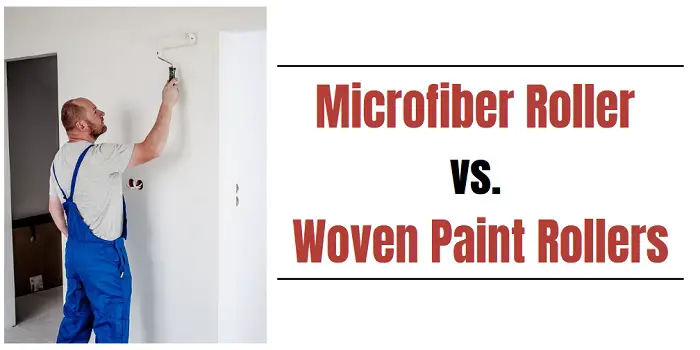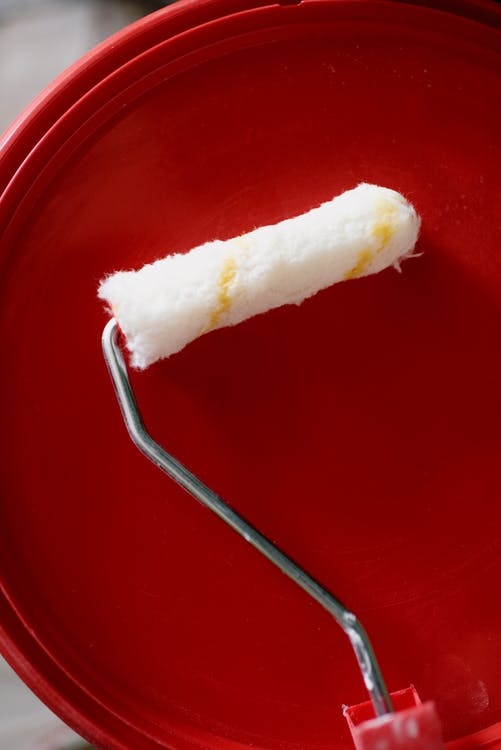Can I Use Microfiber Roller for Acrylic Paint

For your painting projects, one of the more useful items is the microfiber roller.
This handy item will help you get a more consistent effort when you are painting, either indoors or outdoors.
A microfiber roller looks in many ways like a traditional woven paint roller.
But the basic difference and benefit are that the roller itself is wrapped in microfiber fabric/cloth.
With the fibers on the cloth being so small, they are quite durable and rarely fleck or detach from the roller when painting.
Another reason that makes the fibers on microfiber rollers exceptionally strong is it's attached to epoxy, which helps to keep them in place for very long.
And that's the reason I would choose microfiber rollers over woven, particularly when my aim is to get the smoother and shinier finish.
What's Here in the Article:
What is Microfiber Roller Made Of?
The fibers themselves may be made from different synthetic materials, such as the following…
- Kevlar
- Nomex
- Nylon
- Polyamide
- Polyester
- Polypropylene
- Trogamide
The fibers of microfiber rollers may consist of one or more synthetic materials, depending on the manufacturer.
And the fibers themselves are thinner than a single thread of silk, making them about 1/5th the diameter of a human hair.
Benefits of Microfiber Rollers
Many professional painters use microfiber rollers for good reasons.
They offer a series of benefits that traditional woven rollers cannot accomplish.
Being free of lint and holding more than 50% of the paint compared to a similar-sized traditional roller, the advantages of a microfiber roller are considerable.
1- Easier to Use
Because they hold more paint, they require less effort to use.
This means smoother results, which can enhance the surface.
2- Smooth Application
The amount of paint combined with the thin nature of the fibers means you get smooth, clean results.
This is especially true when using glossy finishes as the microfiber roller really brings out the shine.
That is because the thin nature of the fibers lessens the chance for roller marks or indentations that otherwise dull the finish from glossy paints.
3- More Economical
Since they hold considerably more paint, it means you can dip the roller less often.
The result is more time painting and less time going back and forth to the paint tray.
This also means you spend less time overall on the job.
4- Less Splatter
Being lint-free and holding more paint securely translates to less splatter on surfaces.
While you should still take the proper precautions, it does mean less of a clean-up after you have completed the painting project.
The only caveat is that that roller should be cleaned after you stop for a predetermined length of time or when you notice dirt or grit in the roller itself.
5- Durable
The microfiber is tough, long-lasting, and easy to clean.
This means that you can use them again and again on surfaces as long as you clean them properly afterward.
It also helps if you clean the surface before painting so that no grit or debris gets mixed into the paint or roller.

Microfiber vs. Woven Paint Roller
Although microfiber roller covers come with various advantages, there are instances where rollers made of woven materials can be highly useful.
Unlike microfiber rollers, woven paint roller covers are designed with 90° angles, which produces a very tight cross-section of fibers, making these rollers virtually lint-free.
This means that when your project requires producing a smoother high gloss finish without shedding any fibers, you can rely on these woven materials.
Another advantage of using woven roller covers is they can be used for applying various paint types including enamels, latex, epoxies, and with various finishes like flat, satin, eggshell, semi-gloss, or high-gloss.
The only downside with traditional woven rollers is, you can see the flaws in the paint when the fibers come loose.
And that's where microfiber rollers stand out.
They are not only much smaller but are attached to the roller using a heating process which makes them even more durable and long-lasting.
In addition, microfibers are quite good at absorbing liquids such as both water and oil-based paint.
However, the fibers themselves are soft enough to not scratch or damage most surfaces.
The exception being if the paint or roller has been contaminated with grit, dirt, or other harder elements.
How to Choose and Use Your Roller Cover?
You may find yourself at the hardware store looking over paint roller covers that are thick, thin, and in different colors.
It is understandable why you might ask what is the difference?
Choosing the right one will help you make your painting project go smoother, so it is important to select the right roller cover for the job.
The most important factor in choosing the right roller cover is the sheen of the paint that you are using.
Understanding that will help you select the roller cover that helps make your paint job easier.
Gloss & Semi-Gloss
These paints have a very high level of sheen. This means that it will show more lint on the surface from the action of the paint roller.
Therefore, you should choose a shed-resistant woven color for the job.
Woven fabric uses a double-lock process that creates a smooth finish that is virtually free of any lint.
Eggshell, Flat, & Satin
Although seemingly similar to gloss or semi-gloss, these types of paint require a knit roller cover.
Such covers can absorb and distribute higher amounts of paint as compared to those made from woven fabrics.
This is because knit covers are more open thanks to their looped backing that was made using a single pass-through process.
However, you can still use a shed-resistant woven roller cover with flat or satin paints as that will provide a professional finish.
Another consideration is foam and microfiber roller covers. They work well with most types of paint, enamel, or varnish.
When used on doors, cabinets, and other surfaces that are smooth, using such covers can create an almost spray-like finish.
Best Nap Height Based on Surface Texture?
Now that you have selected between the knit and woven roller covers, the next step is choosing the right nap height.
This is the length of fibers that extends from the backing.
It also carries the paint to the surface, so you will need to choose the right height for the best results.
Shorter naps are perfect for smooth surfaces and particularly drywall.
To evenly apply the paint, a nap height of 3/16 to ¼ should work fine.
Keep in mind that shorter naps pick up less paint, so if time is of concern, then you should use a longer nap.
However, the longer the nap, the more it will add texture to the surface. If this is not desirable for smooth surfaces, then stick to the shorter nap height.
Higher naps are best for textured surfaces. You should use naps that are ¾ to 1-1/2" so the longer fibers can reach into the crevices of the texture.
Surfaces such as brick, concrete blocks, corrugated metal, decks, siding, stucco, or textured plaster are perfect for greater nap height roller covers.
Basically, the rougher the surface, the higher the nap height should be to fully cover the area.
This also makes painting easier as more paint is applied by the roller cover.
Few Additional Tips
You now have the right roller cover material and nap height for your project.
You can start by applying the roller cover, which can be accomplished by aligning the hole with the end of the frame and pushing it into place.
What follows are a few more tips that will help garner the best results.
Add Extensions:
You can add extension poles to each roller frame, so you can reach higher places without needing a ladder for painting.
Apply Even Pressure:
A light, even pressure is more than enough to evenly apply the paint.
Rounded End Rollers:
This will prevent roller edge lines from forming when you paint.
Remember to clean the roller cover after every use. If you are using latex paint, use soap and water to clean the cover.
Otherwise, putting the cover under running water and squeezing out the paint will work. Then, let it completely dry before putting it away.
This will ensure that your roller cover will be ready to use for your next paint job.
What Projects Can You Use a Microfiber Roller For?
Perhaps the best type of project to use a microfiber roller is when you have a considerable amount of surface to cover.
If you are repainting the inside of your home, then a microfiber roller will hold up to four times its volume in terms of paint.
That means you paint more and add paint less to the roller.
The paint will go farther, so you can get more done in less time.
If you want to achieve a smooth finish for painting surfaces such as walls and high ceilings, then the microfiber roller is a perfect choice.
Because they leave behind a minimum of texture compared to a traditional woven roller, the microfiber roller is especially good when using glossy paint.
For surfaces in which you want to maximize the reflective nature of the glossy paint, then you should start with a microfiber roller.
This is because the less texture on a surface, the more reflectivity the paint will offer.
Any imperfections will not reflect the light properly, leading to a duller finish.
When Should You Not Use Microfiber Paint Rollers?
If your goal is to see the roller marks or brush strokes, then the microfiber roller is not for you.
It works to hide any texture, not reveal it. But that is not the only issue.
If the surface area is rough, such as stucco, masonry, or brick, then using a microfiber roller is rather pointless.
It will have exactly the same effect compared to a standard woven roller.
Furthermore, the rough surface can damage the fine microfibers on the roller, damaging it to the point where you do not want to use them again.
Final Thoughts
When choosing the best paint roller for a smooth finish, microfiber and wooven paint roller are the two options that come to most minds.
These roller covers come in a variety of different brands and colors (such as white, yellow, or even blue).
Knowing which one to choose based on your project requirements will not only help you ease your paint job, but will allow you to get a smoother finish with lesser flaws.
Share the post "Why is Microfiber Roller Better Than Woven Paint Roller?"

Douglas Becker (aka Painter Doug) has over twenty years of experience as a painter in Adkins, Texas. At present, he resides in Florida with his family.
From painting multi-storeyed houses, condos, and apartments to large commercial buildings and small offices, he had served various customers in areas not only in Adkins but also in Southwest Florida, Sarasota, Naples, and many more. To know more about him check here.
Can I Use Microfiber Roller for Acrylic Paint
Source: https://painterdoug.com/microfiber-roller/
0 Response to "Can I Use Microfiber Roller for Acrylic Paint"
Post a Comment